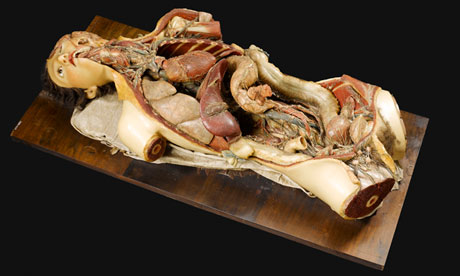Much praise has been lavished on the Museum of London's 'Doctors, Dissection and Resurrection Men' exhibition. With its gruesome topic, expensive exhibition design, and aggressive Tube advertising scheme, it has been an instant hit. True, it is very well done, visually stunning, thoughtfully laid out and atmospheric. But is it really that good? I would say, yes, yes it actually is. Because not only has the Museum of London delivered a stylish show, it uses visual media to perfection to entertain and engage the visitors with the otherwise dry story of the politics of the human body.
What the exhibition does so well can be summarized not in any of it's displays of impressive wax works or skeletal remains, but in the media space isolated from the exhibition by red plastic curtains. Visitors are invited to sit in the round (an echo of an operating theatre?) and listen to admittedly simplified versions of the arguments which surrounded the controversial Anatomy Act of 1832. We hear voices from both sides of the issue passionately debating the main topics addressed by the Act, accompanied by evocative sound effects which attempt to bring the visitor directly into the Parliament debate. As I sat and listened to each side passionately condemning or defending surgeons using the bodies of the unclaimed poor in their training, it dawned on me that at no point in the exhibition had the 'resurrection men' actually been condemned.
Most people come to an exhibition about grave robbers for it's morbid fascination, but the Museum of London has managed to deliver an exhibition that is deliciously dark while actually contextualising the 'unholy' union between London's schools of anatomy and the resurrectionists. It would be far to easy to look back on this period of time in disgust and the exhibit is very careful to at all times ensure that the highest of surgeons is implicated alongside the most notorious of body snatcher. Listening to the arguments for and against the Anatomy Act, it becomes clear that the hunched thieving characters we know today from books and films were very clearly a product of their social context. The interest of the body snatching phenomenon lies as much in the invention of 'man-traps' as it does with the rapid expansion of the urban population in early nineteenth century London, or wide-held religious beliefs around literal resurrection. Quite rightly, the exhibition ends with a meditation on issues of consent and our bodies as it stands today, and we can see that the issues faced by some of our most memorable surgeons and their unfortunate 'Subjects' is very much still applicable today.
 |
| 18th century waxwork anatomical model used to train surgeons on display at the Museum of London |
I think the Museum of London has really tied together some of the things that the museum field is trying to achieve in it's temporary exhibitions. It's a crowd pleaser for sure with it's macabre subject matter, anatomy inspired wall-paper and well-designed interactives. But the exhibition never patronises the audience and never criticizes part people for their actions, but rather presents them in the social context. My only criticism is I wish there had been more human remains to supplement the very well placed archival material and wax models. I know using human tissue is in itself a bit contentious, but if you are going to have some (which the exhibition does) then use it to effect. My heart goes out to rooms and rooms of disused wet specimens from bodies hawked by the resurrection men to London's most famous surgeons. Maybe I just love pots more than bones.
Resurrection Men is a well designed and immersive exhibition with plenty to take away. You could go and just enjoy meeting some of London's most famous body-snatchers in the form of Williams, Bishop and May, walk the streets of medical London, see the bones of anatomised corpses pulled from a hospital graveyard, or have a good think about organ donation in modern medicine. This is a show we'll be talking about for years, so don't miss out!
Resurrection Men is a well designed and immersive exhibition with plenty to take away. You could go and just enjoy meeting some of London's most famous body-snatchers in the form of Williams, Bishop and May, walk the streets of medical London, see the bones of anatomised corpses pulled from a hospital graveyard, or have a good think about organ donation in modern medicine. This is a show we'll be talking about for years, so don't miss out!

_museum_of_london__gallery_image.jpg)
A very good piece of post and the suggestion you have given is worth thinking about. As for doctors appraisal, GMC has taken steps to improve the system as the first phase of the revalidation is coming to an end.
ReplyDelete